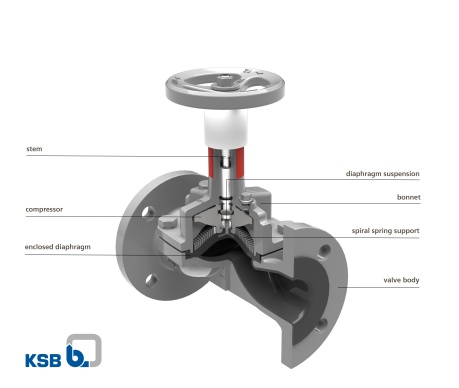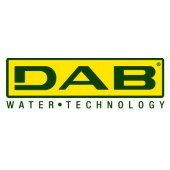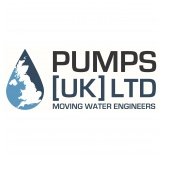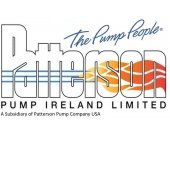Handling aggressive media with industrial diaphragm valves

Marc Walker, UK Valves Sales Manager at KSB, explains how, thanks to their design, diaphragm valves are particularly suited to applications containing toxic or corrosive media.
The transfer of liquids in process operations is an everyday function in many industry sectors, which demands system designers and operators to give maximum attention to the mechanical elements required for optimum performance. One of those essential elements is the valve. Where the valve performs the role of a throttle device, weir type and straight-through diaphragm valves provide the most appropriate function.
The diaphragm valve is an economical solution for applications where the media being handled is corrosive or toxic. High levels of safety are paramount and are usually satisfied by alloy metal valves that can be positioned close to pumps, bends, and in both horizontal and vertical pipelines. This has the advantage of eliminating the presence of a dead zone in the fluid chamber, preventing the accumulation of deposits which could cause contamination of the media being handled.
The general appeal of industrial diaphragm valves is that none of the actuating elements in the valve bonnet come into contact with the media at any point in its passage through the valve. Quite simply, there can be no functional impairment or corrosion of the components. Valve operation reliability is, therefore, ensured at all times, whether the operation is intermittent or just once every few years.
Common to virtually all diaphragm valves is the external body shape, and, internally, the pre-drilled diaphragm, which is sandwiched between the bonnet and the valve body. However, there is an exception to this concept, and it comes from KSB. Externally its weir type valves look just like all other diaphragm valves, but internally there is a significant difference: the diaphragm is wholly enclosed in the valve chamber within the recess on the valve body’s cover flange. Having supplied customers in many countries with this type of diaphragm design and monitoring the results achieved by customers, KSB affirms that its concept of the enclosed diaphragm delivers considerable advantages over other valve types.
KSB DIAPHRAGM VALVES
KSB’s diaphragm valve range encompasses the SISTO-KB straight-through valve and the SISTO 16/SISTO-20 weir type valves with enclosed diaphragm and spiral spring support. Compliant with all relevant international standards, these valves are all available with various linings, coatings and diaphragms and can be equipped with a range of actuators and accessories.
“KSB’s unique sealing system consists of a chambered diaphragm enclosed in the valve body backed up by a spiral spring support on the back of the diaphragm,” explained Marc Walker, UK Valves Sales Manager at KSB. “This arrangement ensures that 100% of the diaphragm surface area is supported from the back at all times and prevents uneven pressure points when the valve is closed or in an intermediary position. On top of this, the diaphragm pin is screwed into the compressor and is held through a balanced suspension while remaining manoeuvrable. This avoids specific point loading on the diaphragm during closure so that when pressure is increased the diaphragm cannot tear”.
The perfect tightness and the fixed position of the diaphragm in its recess provides hermetic sealing to the atmosphere, minimising the potential for media leakage, which is particularly relevant for duties where toxic media is involved. The wholly enclosed and supported diaphragm maximises the service life and the pressure limit of the diaphragm.
Due to the unique sealing system of a chambered diaphragm, the KSB PIN-16 design enables its valves to accept a maximum pressure of 20 bar and temperatures of up to 160°C in certain applications. The lining/coating technology used to protect the valve body from abrasion and corrosion is another critical element in its appeal to a broad spectrum of industrial users. A further advantage of this group of valves is ease of maintenance and replacement. Should it be necessary to replace the diaphragm this can be done without having to dismantle the valve body and without using specialist equipment or measuring tools.
“KSB operates a vertically integrated production and in-house manufacturing operation incorporating research and development resources,” continued Marc. “This approach enables the company to have complete manufacturing and quality control of all its products”. Central to the company’s product development programmes is research into new materials and technologies, which introduces state-of-the-art equipment offering components with the highest reliability. “For example,” said Marc, ”use of finite element (FEM) analysis in the development of diaphragms has allowed the company to speed up the introduction of new concepts, as well as contributing to reliability and performance”.
These attributes have established KSB’s diaphragm valves in fertiliser production, ore processing, chlorine production, raw water or ballast water treatment, gas scrubbing, and food and beverage processing. www.ksb.com
Back to Latest News


3.png&w=170&h=170)


2.jpg&w=170&h=170)





1.png&w=170&h=170)
